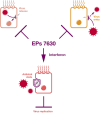Multiple mechanisms enable broad-spectrum activity of the Pelargonium sidoides root extract EPs 7630 against acute respiratory tract infections
- PMID: 39469622
- PMCID: PMC11513585
- DOI: 10.3389/fphar.2024.1455870
Multiple mechanisms enable broad-spectrum activity of the Pelargonium sidoides root extract EPs 7630 against acute respiratory tract infections
Abstract
There is clinical evidence showing that the Pelargonium sidoides root extract EPs 7630 is a safe and effective treatment for a range of acute infectious respiratory illnesses. Moreover, EPs 7630 has been shown to reduce the use of antibiotics, which is important in the context of rising antibiotic resistance levels. A wide range of mechanisms appears to contribute to the beneficial effects of EPs 7630, e.g. antibacterial, antiviral, immunomodulatory, and epithelial barrier effects. This broad spectrum of pharmacological activities seems to enable the clinical activity of EPs 7630 against multiple respiratory infections. In particular, the combination of antiviral and immunomodulatory effects may enable EPs 7630 to tackle acute viral respiratory infections both in early stages of the disease process, which are driven by virus replication, as well as in later stages, which are caused by an overshooting immune response. Hence, EPs 7630 is a prime example of a plant extract with evidence-based clinical efficacy, including a solid understanding of the underlying mechanisms of action. The example of EPs 7630 demonstrates that plant extracts have a potential role as evidence-based clinical treatments and that they deserve pre-clinical and clinical testing and investigation in the same way as any other drug class.
Keywords: antibacterial; antiviral; bacteria; herbal drugs; immunomodulation; infectious disease; interferon; virus.
Copyright © 2024 Cinatl, Wass and Michaelis.
Conflict of interest statement
Authors JC, MW, and MM received a consultancy fee for the preparation of this review article from Dr. Willmar Schwabe GmbH & Co. KG, Karlsruhe, Germany. Moreover, the article processing fee was paid by Dr. Willmar Schwabe GmbH & Co. KG. The funder had the following involvement in the study: Support with the identification of relevant literature, critical proofreading; support with the design of figures. The author(s) declared that they were an editorial board member of Frontiers, at the time of submission. This had no impact on the peer review process and the final decision.
Figures





Similar articles
-
Antimicrobial, Antiviral and Immunomodulatory Activity Studies of Pelargonium sidoides (EPs® 7630) in the Context of Health Promotion.Pharmaceuticals (Basel). 2011 Oct 10;4(10):1295-1314. doi: 10.3390/ph4101295. Pharmaceuticals (Basel). 2011. PMID: 27721327 Free PMC article. Review.
-
Unlocking the therapeutic potential of Pelargonium sidoides natural extract: A scoping review.Heliyon. 2024 Nov 20;10(23):e40554. doi: 10.1016/j.heliyon.2024.e40554. eCollection 2024 Dec 15. Heliyon. 2024. PMID: 39654721 Free PMC article.
-
Investigation of the influence of EPs® 7630, a herbal drug preparation from Pelargonium sidoides, on replication of a broad panel of respiratory viruses.Phytomedicine. 2011 Mar 15;18(5):384-6. doi: 10.1016/j.phymed.2010.09.008. Epub 2010 Oct 30. Phytomedicine. 2011. PMID: 21036571 Free PMC article.
-
Evaluation of pharmacodynamic activities of EPs® 7630, a special extract from roots of Pelargonium sidoides, in animals models of cough, secretolytic activity and acute bronchitis.Phytomedicine. 2015 Apr 15;22(4):504-9. doi: 10.1016/j.phymed.2015.03.004. Epub 2015 Mar 20. Phytomedicine. 2015. PMID: 25925973 Free PMC article.
-
HATRIC: a study of Pelargonium sidoides root extract EPs®7630 (Kaloba®) for the treatment of acute cough due to lower respiratory tract infection in adults-study protocol for a double blind, placebo-controlled randomised feasibility trial.Pilot Feasibility Stud. 2019 Jul 31;5:98. doi: 10.1186/s40814-019-0478-6. eCollection 2019. Pilot Feasibility Stud. 2019. PMID: 31384480 Free PMC article.
Cited by
-
Effects of Pelargonium Sidoides Extract on Apoptosis and Oxidative Stress in Human Neuroblastoma Cells.Medicina (Kaunas). 2024 Dec 23;60(12):2110. doi: 10.3390/medicina60122110. Medicina (Kaunas). 2024. PMID: 39768989 Free PMC article.
References
-
- Abdel Bar F. M., Alossaimi M. A., Elekhnawy E., Alzeer M. A. A., Abo Kamer A., Moglad E., et al. (2022). Anti-quorum sensing and anti-biofilm activity of Pelargonium × hortorum root extract against Pseudomonas aeruginosa: combinatorial effect of catechin and gallic acid. Molecules 27, 7841. 10.3390/molecules27227841 - DOI - PMC - PubMed
-
- Abdel Menaem H. N., Moustafa M. A., Sarhan R. M., William S. A., Abdel Rahman A. A. (2022). Experimental in vivo assessment of immunomodulatory effect of Kalobin (Pelargonium reinforme/sidoides extract) on schistosomiasis mansoni . Parasitol. United J. 15, 71–85. 10.21608/puj.2022.100824.1138 - DOI
-
- Alossaimi M. A., Alzeer M. A., Abdel Bar F. M., ElNaggar M. H. (2022). Pelargonium sidoides root extract: simultaneous HPLC separation, determination, and validation of selected biomolecules and evaluation of SARS-CoV-2 inhibitory activity. Pharm. (Basel) 15, 1184. 10.3390/ph15101184 - DOI - PMC - PubMed
-
- Amer S. E., El-Shazly K. A., El-Shazly S. A. (2006). Immunostimulating effects of Pelargonium reinforme/sidoides extract (Kalobin®) on mice infected with Prohemistomum vivax. Egypt. J. Exp. Biol. Zool. 2, 117–121.
Publication types
LinkOut - more resources
Full Text Sources
Molecular Biology Databases

